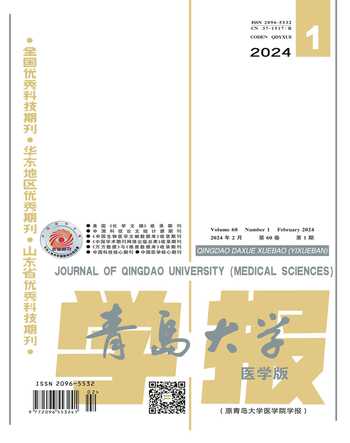非糖尿病非痴呆人群空腹血糖与AD脑脊液生物标志物关系
刘文慧 谭兰


[收稿日期]2023-01-03; [修訂日期]2023-05-20
[基金项目]山东省泰山学者项目基金(NO.ts201511109)
[第一作者]刘文慧(1996-),女,硕士研究生。
[通信作者]谭兰(1961-),女,博士,主任医师,博士生导师。E-mail:dr.tanlan@163.com。
[摘要] 目的
探讨非糖尿病非痴呆人群空腹血糖(FBG)水平与阿尔茨海默病(AD)脑脊液生物标志物的关联。
方法 从AD神经影像学数据库中选取1 158名非糖尿病非痴呆参与者作为研究对象,分别采用多元线性回归模型和线性混合效应模型,分析FBG水平与AD脑脊液生物标志物β淀粉样蛋白(Aβ)、总tau(t-tau)蛋白和磷酸化tau(p-tau)蛋白的横向和纵向关联。
结果 横截面分析显示,FBG水平与t-tau(β=0.124,P=0.001)和p-tau(β=0.113,P=0.003)呈正相关,与Aβ42无相关性(β=0.067,P=0.144);FBG水平与t-tau(β<0.001,P=0.025)和p-tau(β<0.001,P=0.014)的纵向积累有关,与Aβ42的纵向变化无关(β=-0.004,P=0.716)。亚组分析显示,在女性参与者中,FBG水平与t-tau(β=0.119,P=0.002)和p-tau(β=0.129,P=0.024)呈正向相关,而在男性中FBG仅与t-tau呈正相关(β=0.101,P=0.047);FBG与t-tau(β=0.118,P=0.004)和p-tau(β=0.110,P=0.007)的正向关联仅在65岁以上的参与者中存在;在APOE ε4基因携带者中FBG水平升高与t-tau(β=0.160,P=0.012)和p-tau(β=0.154,P=0.017)的增长相关。
结论 FBG水平与脑脊液中t-tau、p-tau存在显著正相关性,FBG水平降低可能对AD病理改变有保护作用。
[关键词] 阿尔茨海默病;血糖;脑脊髓液;生物标记
[中图分类号] R745.7
[文献标志码] A
[文章编号] 2096-5532(2024)01-0063-04
doi:10.11712/jms.2096-5532.2024.60.030
[开放科学(资源服务)标识码(OSID)]
[网络出版] https://link.cnki.net/urlid/37.1517.R.20240329.0928.003;2024-04-01 11:48:06
Association of fasting blood glucose with cerebrospinal fluid biomarkers for Alzheimers disease in the non-diabetic population without dementia
\ LIU Wenhui, TAN Lan
\ (Department of Neurology, Qingdao Municipal Hospital, Qingdao University, Qingdao 266011, China)
\; [Abstract]\ Objective\ To investigate the association of fasting blood glucose (FBG) with cerebrospinal fluid biomarkers for Alzheimers disease (AD) in the non-diabetic population without dementia.
\ Methods\ A total of 1 158 non-diabetic participants without dementia were selected as research subjects from AD Neuroimaging Initiative database. The multiple linear regression mo-
del and the linear mixed-effects model were used to investigate the cross-sectional and longitudinal relationships between FBG level and the cerebrospinal fluid biomarkers for AD including β-amyloid (Aβ), total tau (t-tau), and phosphorylated tau (p-tau).
Results\ The cross-sectional analysis showed that FBG was positively associated with t-tau (β=0.124,P=0.001) and p-tau (β=0.113,P=0.003) and was not associated with Aβ42 (β=0.067,P=0.144); FBG level was associated with the longitudinal accumulation of t-tau (β<0.001,P=0.025) and p-tau (β<0.001,P=0.014) and was not associated with the longitudinal changes of Aβ42 (β=-0.004,P=0.716). The subgroup analysis showed that in female participants, FBG level was positively associated with t-tau (β=0.119,P=0.002) and p-tau (β=0.129,P=0.024), while in male participants, FBG was only positively associated with t-tau (β=0.101,P=0.047). FBG was positively associated with t-tau (β=0.118,P=0.004) and p-tau (β=0.110,P=0.007) only in participants aged 65 years and above. In APOE ε4 gene carriers, the increase in FBG level was associated with the increases in t-tau (β=0.160,P=0.012) and p-tau (β=0.154,P=0.017).
\ Conclusion\ FBG level is positively associated with t-tau and p-tau in cerebrospinal fluid, and lowering FBG level may have a protective effect against pathological changes in AD.
[Key words]\ Alzheimer disease; blood glucose; cerebrospinal fluid; biomarkers
阿尔茨海默病(AD)是老年人痴呆的主要原因,临床主要表现为不可逆的认知功能下降和记忆力减退[1]。目前对AD没有有效的治疗措施,因此,确定AD潜在的风险因素并提前进行干预是非常重要的[2-3]。在AD发生之前,脑脊液核心标志物就已经发生了变化,与AD相关的核心生物标志物被广泛用于AD的诊断[4]。大量研究表明,2型糖尿病是AD的一个危险因素,会增加患痴呆症风险[5-7]。大多数研究侧重于糖尿病本身与AD发病率关系,本文研究则侧重于空腹血糖(FBG)与AD病理的关系,旨在探讨FBG是否与无糖尿病的非痴呆老年人的脑脊液神经变性生物标志物的基线和纵向变化有关,并研究性别、年龄和载脂蛋白E(APOE)ε4对脑脊液生物标志物和FBG之间关系的影响。
1 资料和方法
1.1 研究对象
研究对象均来自于阿尔茨海默病神经成像计划(ADNI)数据库[8]。基线资料包含脑脊液测量数据、FBG数据和人口统计资料的个体被纳入本文研究。参与者的纳入和排除标准与既往研究一致[8]。为了减少复杂的血糖状态对结果的影响,在“既往病史”和“用药史”中搜索基线诊断信息,检索词包括“糖尿病”和“糖尿病病人”以及“降糖药物服用史”,以排除那些有明确的糖尿病诊断和有降糖药物服用史的人。最终,共有1 158名非痴呆症病人被纳入横断面研究,其中506人参与了纵向随访,并被纳入纵向研究。根据1999年世界卫生组织(WHO)提出的糖尿病诊断标准,参与者被分为低血糖组(A组,FBG<3.9 mmol/L)、正常血糖组(B组,FBG 3.9~6.0 mmol/L)、空腹血糖受损组(C组,FBG 6.1~6.9 mmol/L)以及临时诊断的糖尿病组(D组,FBG≥7.0 mmol/L,FBG水平仅有1次达到糖尿病诊断标准,未诊断为糖尿病)。
1.2 AD脑脊液生物标志物和FBG检测
由宾夕法尼亚大学多重xMAP Luminex平台(Luminex Corp, Austin)检测研究对象脑脊液中β淀粉样蛋白42(Aβ42)、总tau(t-tau)和磷酸化tau(p-tau)蛋白的水平,重复测量并取其平均值[9]。研究对象夜间禁食10 h后,以非抗凝真空采血管采集静脉血2 mL,迅速低温离心分离血清后-80 ℃冰箱保存。用全自动生化分析仪测定FBG。
1.3 统计学分析
使用R 4.0.0软件进行统计学分析。通过R软件的“car”包对FBG数据进行正态化处理。连续变量多组间比较采用Kruskal-Wallis检验,两组之间比较采用Mann-Whitney检验。分类变量组间比较采用χ2检验。应用多变量线性回归分析FBG水平与脑脊液标志物的基线水平的关系,并采用线性混合效应模型分析FBG水平与AD生物标志物的纵向关系。线性混合效应模型包括时间的随机截距和斜率以及随机效应的非结构协方差矩阵[10];将时间和因变量的相互作用视为预测因子,通过校正协变量对t-tau和p-tau的纵向变化速率进行评估。建立带有交互项的模型研究性别、年龄和APOE ε4对FBG水平和AD脑脊液生物标志物之间关系的修饰作用,在交互作用有意义的情况下进行亚组分析。所有分析均对年龄、性别、教育程度、APOE ε4携带者状态、体质量指数(BMI)和基线诊断进行校正。以P<0.05为差异有显著性。
2 结 果
2.1 研究对象的人口学特征
本文1 158名研究对象中包括387名认知正常者(CN)和771名轻度认知损害者(MCI)。总人群年龄54~91岁,平均(73.56±7.10)岁;男631名,女527名;简易智力状态检查量表(MMSE)平均得分为(28.07±1.77)分,平均受教育年限为(16.09±2.79)年,FBG平均水平为(5.45±0.90)mmol/L,BMI為(26.79±4.53)kg/m2,APOE ε4携带者占比43.18%。不同血糖水平各组间年龄、性别、教育水平、MMSE得分、APOE ε4携带、BMI差异无显著性(P>0.05);各组间FBG比较差异有统计学意义(H=13.71,P<0.001)。见表1。
2.2 不同血糖水平组间脑脊液生物标志物的比较
各组t-tau、p-tau比较差异有统计学意义(H=14.927、13.032,P<0.01),Aβ42水平差异无显著性(P>0.05)。两两比较结果显示,血糖正常组与空腹血糖受损组的t-tau、p-tau水平差异无统计学意义(P>0.05),临时诊断糖尿病组的t-tau和p-tau水平与血糖正常组、空腹血糖受损组差异有显著性(Z=-3.005~-2.646,P<0.01)。见表1。
2.3 总人群FBG水平与AD脑脊液生物标志物的横向关系
在校正了年龄、性别、教育程度、APOE ε4状态、BMI和基线诊断后进行多元线性回归分析,结果显示,在整个队列中FBG水平与t-tau(β=0.124,P=0.001)和p-tau(β=0.113,P=0.003)呈正相关,但与Aβ42(β=0.067,P=0.144)无关。见表2。
2.4 性别、年龄、APOE ε4状态对FBG与脑脊液tau相关标志物相关性的影响
交互模型显示,性别(β=0.022,P<0.001)、年龄(β=0.002,P<0.001)和APOE ε4(β=0.081,
P<0.001)对FBG与t-tau的关联有明显的交互作用。性别(β=0.042,P<0.001)、年龄(β=0.002,P<0.001)、APOE ε4状态(β=0.085,P<0.001)对FBG与脑脊液p-tau的关联也有显著交互作用。按性别、年龄和APOE ε4分层分析显示,FBG与t-tau(β=0.118,P=0.004)和p-tau(β=0.110,P=0.007)的关联仅在65岁以上的研究对象中存在;在APOE ε4基因携带者中,FBG水平与t-tau(β=0.160,P=0.012)和p-tau(β=0.154,P=0.017)存在关联;在女性中,FBG与t-tau(β=0.119,P=0.002)和p-tau(β=0.129,P=0.024)有关,而在男性中FBG仅与t-tau(β=0.101,P=0.047)有关。见表2。
4组间FBG、p-tau、t-tau比较,H=13.032~14.927,P<0.01;与A组、C组比较,*Z=-3.005~-2.646,P<0.01。
2.5 总人群中FBG水平与AD脑脊液生物标志物的纵向关系
线性混合模型分析显示,FBG水平与t-tau(β<0.001,P=0.025)和p-tau(β<0.001,P=0.014)的纵向改变呈正相关,与纵向Aβ42无明显关联(β=-0.004,P=0.716)。
3 讨 论
本研究分析了非糖尿病非痴呆人群中FBG与脑脊液生物标志物的横向和纵向关系,结果显示,FBG水平与t-tau、p-tau蛋白的水平显著相关,高FBG水平与tau相关蛋白的快速升高相关。证明了控制血糖可能对AD早期病理变化有保护作用,在AD的早期阶段有效控制FBG可能减缓非痴呆老人向AD的发展[11]。
既往有研究表明,AD早期FBG水平与tau相
关生物标志物的关联较与Aβ42的关联更强[12]。有动物研究显示,在糖尿病小鼠模型的大腦皮质和海马中tau蛋白高磷酸化,提示高糖血症与tau修饰密切相关[13]。然而,一些研究认为FBG仅与脑脊液Aβ42水平存在相关性[14-15]。其中年龄可能是造成这些结果差异最关键的因素。我们研究队列中参与者的平均年龄大于其他队列。推测FBG在年轻人群中可能与Aβ42有关,在年龄较大者中与t-tau和p-tau密切相关。多项研究已经证实,糖尿病是痴呆症的一个可能的危险因素[16]。高糖血症可能通过几种潜在的机制导致痴呆风险的增加,其中包括急性和慢性高糖血症、糖尿病相关的微血管病变和胰岛素抵抗[17-18]。未来的研究应关注高糖血症和痴呆症的共同病理基础,以减缓非糖尿病病人痴呆症的发展。
本文按性别分组研究显示,FBG水平与p-tau之间的相关性只在女性中发现,这与相关研究结果一致[19]。FBG水平与t-tau的相关性仅在女性中有显著性,而在男性中有类似的趋势,这可能是因为与糖尿病相关的风险因素可导致代谢综合征,其发病率女性高于男性[20]。本文对APOE ε4携带状态分层分析发现,只有APOE ε4携带者的FBG水平和t-tau、p-tau生物标志物之间存在显著相关性,提示APOE ε4基因型参与了AD风险和糖尿病之间的关联机制。虽然其确切的机制尚不清楚,但有研究显示,APOE ε4和糖尿病可能相互作用,增加动脉硬化的风险,进而增加痴呆的风险[21]。按年龄分组研究显示,只有65岁以上老年人FBG水平与脑脊液t-tau、p-tau存在正相关性。关于年龄如何影响糖尿病和痴呆症之间的关系,需要进一步研究。
本研究以尚未发生糖尿病的个体为研究对象,探讨FBG水平与脑脊液标志物的纵向变化关系。这不仅对以前的横断面研究进行了验证和补充,而且还探索了FBG水平和AD病理之间的机制并提供了潜在的因果关系,这对确定AD风险因素和长期预后很有帮助。本文研究有以下局限性:①只用FBG水平作为糖代谢的指标,未来的研究应该包括胰岛素抵抗和糖化血红蛋白等指标;②研究中低糖血症的参与者太少,无法研究低糖血症与AD之间的潜在关系。
综上所述,在非糖尿病非痴呆人群中,FBG水平与脑脊液中t-tau和p-tau密切相关,这表明控制血糖可能是预防AD的一个有效措施,尤其是对年龄>65岁、女性和APOE ε4携带者。但其确切的病理机制仍需进一步研究,以确定预防和治疗靶点。
[参考文献]
[1]SCHELTENS P, DE STROOPER B, KIVIPELTO M, et al. Alzheimers disease[J]. Lancet (London, England), 2021,397(10284):1577-1590.
[2]SCHIEPERS O J G, KHLER S, DECKERS K, et al. Lifestyle for Brain Health (LIBRA): a new model for dementia prevention[J]. International Journal of Geriatric Psychiatry, 2018,33(1):167-175.
[3]XU W, TAN L, WANG H F, et al. Meta-analysis of modifiable risk factors for Alzheimers disease[J]. Journal of Neuro-
logy, Neurosurgery, and Psychiatry, 2015,86(12):1299-1306.
[4]SHAW L M, VANDERSTICHELE H, KNAPIK-CZAJKA M, et al. Cerebrospinal fluid biomarker signature in Alzheimers disease neuroimaging initiative subjects[J]. Annals of Neurology, 2009,65(4):403-413.
[5]CHENG D, NOBLE J, TANG M X, et al. Type 2 diabetes and late-onset Alzheimers disease[J]. Dementia and Geriatric Cognitive Disorders, 2011,31(6):424-430.
[6]YU J H, HAN K, PARK S, et al. Incidence and risk factors for dementia in type 2 diabetes mellitus: a nationwide population-based study in Korea[J]. Diabetes & Metabolism Journal, 2020,44(1):113-124.
[7]MORAN C, BEARE R, WANG W, et al. Type 2 diabetes mellitus, brain atrophy, and cognitive decline[J]. Neurology, 2019,92(8):e823-e830.
[8]PETERSEN R C, AISEN P S, BECKETT L A, et al. Alzheimers disease neuroimaging initiative (ADNI): clinical characterization[J]. Neurology, 2010,74(3):201-209.
[9]PALMQVIST S, MATTSSON N, HANSSON O, et al. Cerebrospinal fluid analysis detects cerebral amyloid-β accumulation earlier than positron emission tomography[J]. Brain: a Journal of Neurology, 2016,139(Pt 4):1226-1236.
[10]BARON R M, KENNY D A. The moderator-mediator variable distinction in social psychological research: conceptual, strategic, and statistical considerations[J]. Journal of Perso-
nality and Social Psychology,1986,51(6):1173-1182.
[11]LIVINGSTON G, HUNTLEY J, SOMMERLAD A, et al. Dementia prevention, intervention, and care:2020 report of the lancet commission[J]. Lancet (London, England), 2020,396(10248):413-446.
[12]MORAN C, BEARE R, PHAN T G, et al. Type 2 diabetes mellitus and biomarkers of neurodegeneration[J]. Neurology, 2015,85(13):1123-1130.
[13]WU B B, WANG Y J, SHI C G, et al. Ribosylation-derived advanced glycation end products induce tau hyperphosphorylation through brain-derived neurotrophic factor reduction[J]. Journal of Alzheimers Disease, 2019,71(1):291-305.
[14]OU Y N, SHEN X N, HU H Y, et al. Fasting blood glucose and cerebrospinal fluid Alzheimers biomarkers in non-diabetic cognitively normal Elders: the CABLE study[J]. Aging, 2020,12(6):4945-4952.
[15]LI W, RISACHER S L, GAO S J, et al. Type 2 diabetes mellitus and cerebrospinal fluid Alzheimers disease biomarker amyloid β1-42 in Alzheimers Disease Neuroimaging Initiative participants[J]. Alzheimers & Dementia: Diagnosis, Assessment & Disease Monitoring, 2018,10:94-98.
[16]LI T, CAO H X, KE D. Type 2 diabetes mellitus easily deve-
lops into alzheimers disease via hyperglycemia and insulin resistance[J]. Current Medical Science, 2021,41(6):1165-1171.
[17]VERDILE G, FULLER S J, MARTINS R N. The role of type 2 diabetes in neurodegeneration[J]. Neurobiology of Disease, 2015,84:22-38.
[18]CHATTERJEE S, MUDHER A. Alzheimers disease and type 2 diabetes: a critical assessment of the shared pathological traits[J]. Frontiers in Neuroscience, 2018,12:383.
[19]LEE C H, LUI D T W, CHEUNG C Y Y, et al. Different glycaemia-related risk factors for incident Alzheimers disease in men and women with type 2 diabetes—a sex-specific analysis of the Hong Kong diabetes database[J]. Metabolism Research and Reviews, 2021,37(6):e3401.
[20]RANUM A, FREESE R, RAMESH V, et al. Lichen sclerosus in female patients is associated with an increased risk of metabolic syndrome and cardiovascular comorbidities: aretrospective cohort review[J]. The British Journal of Dermatology, 2022,187(6):1030-1032.
[21]PEILA R T, RODRIGUEZ B L, LAUNER L J, et al. Type 2 diabetes, APOE gene, and the risk for dementia and related pathologies: the Honolulu-Asia Aging Study[J]. Diabetes, 2002,51(4):1256-1262.
(本文編辑 黄建乡)

